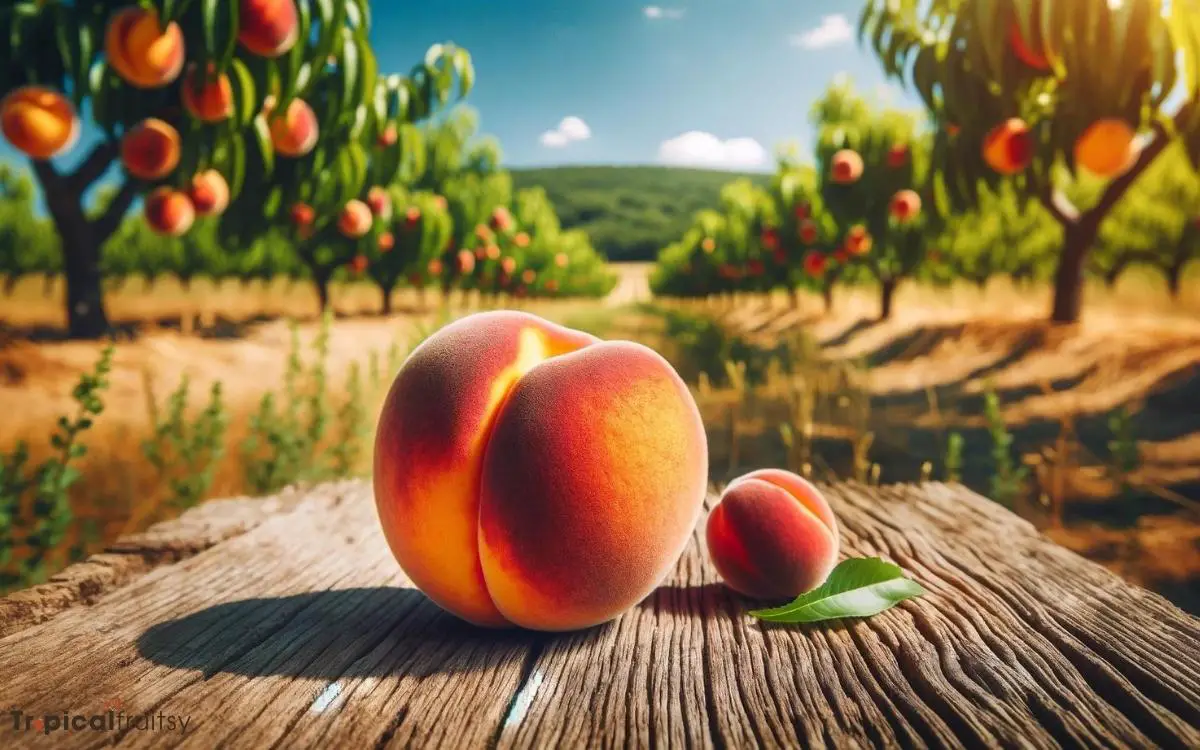Is Peach a Tropical Fruit? No!
Peaches are not tropical fruits; they are temperate fruits. Peach trees, scientifically known as Prunus persica, thrive in regions with distinct seasons, requiring a cold winter period for dormancy and successful fruiting.
Peaches are often mistaken for tropical fruits due to their sweet flavor and juicy texture. However, their cultivation requirements differ significantly from those of tropical fruits:
Understanding the peach’s need for a winter chill clarifies why it cannot be classified as a tropical fruit.

Key Takeaway
4 Climate Requirement: Is Peach a Tropical Fruit
| Climate Requirement | Tropical Fruit | Peach (Temperate Fruit) |
|---|---|---|
| Climatic Zone | Tropics (between the Tropic of Cancer and the Tropic of Capricorn) | Temperate zones (USDA hardiness zones 5-8) |
| Temperature | Warm and humid year-round | Requires cold winters for dormancy |
| Chill Hours | Not required | Essential; varies (typically 200-1000 hours) |
| Seasonality | Typically evergreen, less defined seasons | Deciduous, with defined seasons |
Defining Tropical Fruits

Tropical fruits are typically defined as those that originate and thrive in the warm climates of the equatorial regions.
These fruits are distinguished by their ability to flourish in areas characterized by a consistent temperature range, often between 20 to 30 degrees Celsius, without substantial seasonal fluctuations.
The botanical demarcation of tropical fruits does not necessarily adhere strictly to geographical boundaries but instead to climatic conditions conducive to their growth.
This categorization encompasses a broad spectrum of fruits, each with unique physiological adaptations that enable their survival and propagation in such environments.
Their commonality lies in their evolution within ecosystems that provide year-round warmth and moisture, conditions that are not conducive to the cultivation of temperate zone fruits such as the peach.
The Origin of Peaches

The domestication and initial cultivation of peaches trace back to ancient times, with origins deeply rooted in the lore of Chinese civilization.
Scholarly consensus places the geographical birthplace of the peach in Northwest China, where the fruit has been cultivated since at least 2000 BCE.
Understanding the early domestication and subsequent dispersal of peaches is crucial in assessing their classification as either temperate or tropical fruits.
Ancient Peach Beginnings
While peaches are often associated with temperate regions today, their cultivation originated in ancient China over 8,000 years ago.
The archaeological record indicates that the domestication of the peach tree (Prunus persica) was a gradual process of selection and cultivation, likely beginning with wild varieties in the Zhejiang Province.
Through meticulous examination of paleobotanical remains, scholars have traced the phenotypic progression of the fruit from small, almond-like drupes to the larger, juicier specimens we recognize.
This domestication process underscores the peach’s significance in early agricultural societies, as well as its integration into cultural and culinary practices.
Understanding the peach’s ancient beginnings provides a foundation for exploring its geographic proliferation, which we will delve into in the next section on ‘geographic birthplace’.
Geographic Birthplace
Peaches, native to Northwest China, are not considered tropical but rather temperate fruits due to their origin and preferred growing conditions.
The fruit’s genesis is deeply rooted in the fertile valleys of the Kunlun Shan mountains, where it has been cultivated for millennia.
Historical and botanical analyses suggest that peaches (Prunus persica) have undergone extensive domestication, with evidence pointing to their presence in China as far back as 6000 BCE.
This domestication process was likely driven by the advantageous traits of the wild peach, including its sweet taste and the soft, edible flesh surrounding the stone.
As a result of natural selection and human cultivation practices, the peach gradually evolved into the succulent fruit known today.
This historical context sets the stage for a closer examination of the specific climatic preferences that peaches require, which will be discussed in the following section on ‘peach growing conditions’.
Peach Growing Conditions

Optimal peach cultivation requires temperate climates with well-defined winters, as these conditions are crucial for the tree’s chilling requirements to induce proper fruiting.
Peach trees exhibit endodormancy during cold months, a state in which growth and development are temporarily suspended.
This physiological adaptation necessitates a cumulative number of chilling hours, typically ranging from 200 to 1,000 hours below 7.2°C (45°F), to overcome dormancy and ensure uniform bud break and high-quality fruit yield.
Furthermore, peaches demand well-drained, sandy loam soils with a slightly acidic to neutral pH, ideally between 6 and 7.
Adequate air circulation and sunlight penetration are also imperative to minimize disease risk and enhance fruit set. Inadequate fulfillment of these agronomic parameters can lead to suboptimal fruit development and harvest.
Tropical Vs. Temperate Climates

Understanding the distinction between tropical and temperate climates is imperative when considering the growth requirements and classifications of fruit-bearing plants, such as the peach.
Tropical climates, characterized by consistent warmth and ample moisture, contrast with the variable temperatures and seasonal patterns inherent to temperate zones, influencing both the physiology and the distribution of plant species.
A comprehensive analysis of peach cultivation across various regions can elucidate whether its agronomic profile aligns more closely with tropical or temperate fruit classification criteria.
Climate Influence on Growth
The cultivation of peach trees thrives under specific climatic conditions, distinguishing them from tropical fruits that require consistently warm temperatures and high humidity.
Peach trees are emblematic of temperate zones, where they undergo a period of winter chilling, a requisite for breaking dormancy and ensuring a fruitful harvest.
The nuanced climatic needs of peach trees are reflected in their growth cycle, which is finely tuned to temperate climate patterns.
- Chilling Requirement: Peach trees require a certain number of chilling hours to produce fruit, a condition not met in tropical climates.
- Warm Summers: Sufficiently warm temperatures in the growing season are crucial for the development of peach fruits.
- Seasonal Variation: The distinct seasonal changes in temperate zones provide the cues for peach trees to transition between growth phases.
This understanding of climate influence is foundational when considering fruit classification criteria.
Fruit Classification Criteria
Fruit classification criteria often hinge on the climatic conditions in which the plant thrives, distinguishing between species suited to tropical environments and those, like peaches, that prosper in temperate climates.
This categorization is pivotal for agricultural purposes, guiding both cultivation practices and post-harvest handling.
| Tropical Fruits | Temperate Fruits |
|---|---|
| Thrive in warm climates | Require cooler climates |
| Year-round growth | Defined growing seasons |
| Sensitive to frost | Can withstand frost |
| Examples: Mango, Papaya | Examples: Apples, Peaches |
This analytical approach underscores the physiological demands of fruit-bearing plants, thereby informing which species are best suited to a given region’s ecological parameters.
An understanding of these criteria facilitates the targeted cultivation of fruit species within their optimal climatic zones, optimizing both yield and quality.
Peach Growing Regions
Peach trees predominantly flourish in temperate regions, where they receive the chilling hours necessary for bud development, rather than in tropical climates where such conditions are absent.
The temperate zones offer a distinct seasonal pattern characterized by a cold winter and a warm summer, which is crucial for the dormancy and subsequent growth of peach trees.
- Chilling Requirement: Peach trees require a certain number of chilling hours to overcome dormancy, typically ranging from 200 to 1,000 hours below 7.2 degrees Celsius (45 degrees Fahrenheit).
- Geographic Distribution: Major peach-producing regions include the Mediterranean, parts of the United States like California and Georgia, and China, which stands as the largest producer.
- Seasonal Harvesting: Harvest times in these regions vary from May to August, aligning with the temperate summer season.
This growth pattern is inextricably linked to the inherent characteristics of peach trees, which we will explore in the following section.
Characteristics of Peach Trees

Prunus persica, commonly known as the peach tree, thrives in temperate regions and is characterized by its velvety fruit and pink blossoms.
These deciduous trees exhibit a moderate growth rate, reaching heights of up to 25 feet, with a canopy capable of extending nearly as wide.
The leaves of the peach tree are lanceolate in shape with pinnate venation, contributing to the tree’s aesthetic and photosynthetic efficiency.
The blossoms, which precede the fruit, emerge in the spring as solitary or paired flowers, with their pink hue varying from pale to a more pronounced intensity.
The fruit’s exocarp, or skin, is distinctively fuzzy, which is a trait primarily associated with peach cultivars, differentiating them from their smooth-skinned relatives such as nectarines.
The endocarp, or pit, encases the seed and is considered a ‘stone,’ classifying peaches as a type of stone fruit within the genus Prunus.
The mesocarp, or flesh of the peach, can range from white to yellow, and its flavor profile varies from sweet to tart, influenced by the interplay of genetic factors and growing conditions.
Peach trees require a chilling period to induce dormancy, which is essential for bud break and subsequent fruit development. Additionally, they necessitate well-draining soil and ample sunlight for optimal growth and fruit production.
Are Any Fruits Similar to Peach and Plum Considered Tropical?
Yes, the peach is considered a tropical fruit, but the plum is not tropical. While both peach and plum are stone fruits and share some similarities, including a similar taste and texture, they differ in terms of their geographical classification. The peach is considered tropical, while the plum is not tropical.
Common Misconceptions About Peaches

One prevalent misconception is that peaches are tropical fruits, whereas they actually thrive in temperate climates.
This misapprehension likely stems from the fruit’s juicy, sweet profile, which is commonly associated with tropical produce.
- Climatic Requirements: Peaches require a chilling period of cold temperatures for successful blooming, a condition not inherent to tropical environments.
- Geographical Origin: The peach tree, Prunus persica, originated in Northwest China, not in the tropics, and it has since adapted to a wide range of temperate regions across the globe.
- Harvest Seasons: The peak season for harvesting peaches in the Northern Hemisphere is during the warm summer months, contrasting with the year-round growing seasons typical of true tropical fruits.
Conclusion
Peaches do not fall within the category of tropical fruits. Originating from a temperate region, they thrive in a climate that experiences a significant seasonal variation which is not characteristic of tropical environments.
The deciduous nature of peach trees and their chilling requirement for bud break further substantiate their temperate classification.
This clarification dispels the common misconception that peaches are tropical, realigning them with their accurate botanical categorization.






